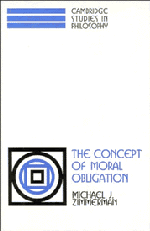Book contents
- Frontmatter
- Contents
- Preface
- Acknowledgments
- 1 Groundwork: Some distinctions
- 2 Moral obligation: An analysis
- 3 The dynamics of obligation
- 4 Conditional obligation
- 5 Prima facie obligation
- 6 Actualism and possibilism
- 7 Dilemmas
- 8 Supererogation
- 9 Cooperation
- Postscript
- Appendix: List of propositions
- List of works cited
- Index of names
- Index of subjects
1 - Groundwork: Some distinctions
Published online by Cambridge University Press: 18 February 2010
- Frontmatter
- Contents
- Preface
- Acknowledgments
- 1 Groundwork: Some distinctions
- 2 Moral obligation: An analysis
- 3 The dynamics of obligation
- 4 Conditional obligation
- 5 Prima facie obligation
- 6 Actualism and possibilism
- 7 Dilemmas
- 8 Supererogation
- 9 Cooperation
- Postscript
- Appendix: List of propositions
- List of works cited
- Index of names
- Index of subjects
Summary
I believe that one ought to do the best one can. You may be inclined to disagree. If you are, I think it's because you don't yet know what I mean. Let me try to explain.
MORAL AND NONMORAL OBLIGATION
I am using the term “ought” to express moral obligation. It is of course sometimes used to express what is required not by morality but by prudence, or law, or aesthetics, or the rules of chess, or whatever. “You ought not to have used so much red,” for example, is likely to constitute aesthetic rather than moral criticism. “You ought to watch your pennies” is likely to constitute prudential rather than moral advice.
This well-recognized fact gives rise to a profound puzzle that I shall mention only to put aside. Suppose that you have investigated your options and reached the disconcerting conclusion that, although morality requires you to do one thing, prudence requires another, and the law yet a third (and aesthetics a fourth, and so on). You might find it hard to decide what to do. You might turn to a friend for advice and say: “This is my situation. What ought I to do?” But what do you mean? “What ought I to do from the moral point of view?” Surely not, for you've already settled on an answer to that question. Similarly, you've already settled on answers to the corresponding questions having to do with the various nonmoral points of view. Presumably, then, you mean, “What ought I to do, period” This is very puzzling.
- Type
- Chapter
- Information
- The Concept of Moral Obligation , pp. 1 - 20Publisher: Cambridge University PressPrint publication year: 1996



